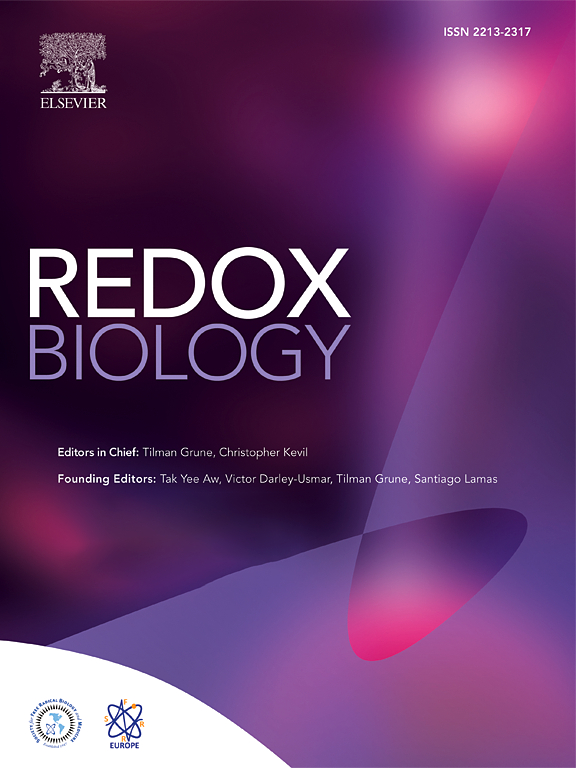The role and mechanism of the cGAS–STING pathway-mediated ROS in apoptosis and ferroptosis induced by manganese exposure
IF 10.7
1区 生物学
Q1 BIOCHEMISTRY & MOLECULAR BIOLOGY
引用次数: 0
Abstract
Environmental exposure to elevated manganese (Mn) levels is significantly associated with neurocognitive deficits, attracting widespread attention, yet its underlying mechanisms remain incompletely defined. Ferroptosis is recognized as a crucial contributor to cognitive impairments. Our study demonstrates that Mn exposure activates the cGAS–STING pathway, mediating reactive oxygen species (ROS) generation and subsequently inducing apoptosis and ferroptosis. Mechanistically, Mn-induced cGAS–STING activation promotes oxidative stress, characterized by increased ROS and malondialdehyde (MDA) production, alongside diminished glutathione peroxidase (GSH-Px) and superoxide dismutase (SOD) activities. Furthermore, this activated pathway triggers apoptosis by mediating ROS-dependent alterations in Bax/Bcl-2 expression and Cytochrome C (Cyt C) release from mitochondria. In addition, excessive activation of the cGAS–STING pathway drives ROS accumulation, which impairs iron homeostasis and induces ferroptosis by regulating the expression of solute carrier family 7 member 11 (SLC7A11), glutathione peroxidase 4 (GPX4), ferroptosis suppressor protein 1 (FSP1), dihydroorotate dehydrogenase (DHODH), and acyl-CoA synthetase long-chain family member 4 (ACSL4). Critically, inhibition of either the cGAS–STING pathway or ROS significantly ameliorated Mn-induced oxidative stress, apoptosis, and ferroptosis. Overall, these findings establish that cGAS–STING pathway activation mediates ROS production, leading to apoptosis and ferroptosis, as an essential mechanism of Mn neurotoxicity. Consequently, targeting the cGAS–STING pathway or ROS represents a promising therapeutic strategy for mitigating Mn neurotoxicity.

cGAS-STING途径介导的ROS在锰暴露诱导的细胞凋亡和铁下垂中的作用和机制
环境暴露于锰(Mn)水平升高与神经认知缺陷显著相关,引起了广泛关注,但其潜在机制尚未完全确定。铁下垂被认为是认知障碍的一个重要因素。我们的研究表明,Mn暴露激活cGAS-STING途径,介导活性氧(ROS)的产生,随后诱导细胞凋亡和铁下垂。在机制上,mn诱导的cGAS-STING激活促进氧化应激,其特征是ROS和丙二醛(MDA)的产生增加,同时谷胱甘肽过氧化物酶(GSH-Px)和超氧化物歧化酶(SOD)活性降低。此外,该激活途径通过介导ros依赖性的Bax/Bcl-2表达和线粒体细胞色素C (Cyt C)释放的改变来触发细胞凋亡。此外,过度激活cGAS-STING通路会导致ROS积累,从而通过调节溶质载体家族7成员11 (SLC7A11)、谷胱甘肽过氧化物酶4 (GPX4)、铁下垂抑制蛋白1 (FSP1)、二氢羟酸脱氢酶(DHODH)和酰基辅酶a合成酶长链家族4 (ACSL4)的表达,破坏铁稳态,诱导铁下垂。关键是,抑制cGAS-STING途径或ROS均可显著改善mn诱导的氧化应激、细胞凋亡和铁下垂。综上所述,这些发现表明cGAS-STING通路激活介导ROS的产生,导致细胞凋亡和铁凋亡,是Mn神经毒性的重要机制。因此,靶向cGAS-STING途径或ROS是减轻Mn神经毒性的一种有前景的治疗策略。
本文章由计算机程序翻译,如有差异,请以英文原文为准。
求助全文
约1分钟内获得全文
求助全文
来源期刊

Redox Biology
BIOCHEMISTRY & MOLECULAR BIOLOGY-
CiteScore
19.90
自引率
3.50%
发文量
318
审稿时长
25 days
期刊介绍:
Redox Biology is the official journal of the Society for Redox Biology and Medicine and the Society for Free Radical Research-Europe. It is also affiliated with the International Society for Free Radical Research (SFRRI). This journal serves as a platform for publishing pioneering research, innovative methods, and comprehensive review articles in the field of redox biology, encompassing both health and disease.
Redox Biology welcomes various forms of contributions, including research articles (short or full communications), methods, mini-reviews, and commentaries. Through its diverse range of published content, Redox Biology aims to foster advancements and insights in the understanding of redox biology and its implications.
 求助内容:
求助内容: 应助结果提醒方式:
应助结果提醒方式:


